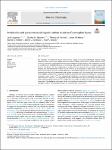Production and preservation of organic carbon in sub-seafloor tephra layers
| dc.contributor.author | Longman, J | |
| dc.contributor.author | Manners, H | |
| dc.contributor.author | Gernon, T | |
| dc.contributor.author | McManus, J | |
| dc.contributor.author | Palmer, M | |
| dc.contributor.author | Rowland, S | |
| dc.contributor.author | Sutton, P | |
| dc.date.accessioned | 2023-11-17T08:32:00Z | |
| dc.date.available | 2023-11-17T08:32:00Z | |
| dc.date.issued | 2024-01 | |
| dc.identifier.issn | 1872-7581 | |
| dc.identifier.issn | 1872-7581 | |
| dc.identifier.other | 104334 | |
| dc.identifier.uri | https://pearl.plymouth.ac.uk/handle/10026.1/21657 | |
| dc.description.abstract |
The deposition of volcanic ash into the ocean initiates a range of chemical and biological reactions. During diagenesis, these reactions may enhance the preservation of organic carbon (OC) in marine sediments, which ultimately promotes CO2 sequestration from the ocean-atmosphere system. However, this interpretation is reliant on a small number of studies that make a link between tephra and OC burial. Here, we compare organic and inorganic geochemical data from tephra-bearing marine sediments from three sites that differ widely in their location, age, and composition. We show that OC is buried in, and proximal to, tephra layers, in proportions higher than would be expected via simple admixture of surrounding sediment. Our data indicate that this OC is preserved primarily through interactions with reactive iron phases, which act to physically protect the carbon from oxidation. Analysis of the composition of the OC associated with reactive iron indicates it is isotopically (consistently more negative δ13C than sediment) and chemically (comprised of compounds not found in the sediment) distinct from OC in the background sediments. We interpret this signal as indicating a microbial source of OC, with autochthonous OC production resulting from autotrophic microbial exploitation of nutrients supplied from tephra. This finding has implications for our understanding of carbon cycling on Earth, and possibly for the emergence of life in terrestrial and perhaps even extra-terrestrial environments. | |
| dc.format.extent | 104334-104334 | |
| dc.language | en | |
| dc.publisher | Elsevier | |
| dc.subject | Tephra | |
| dc.subject | Organic carbon | |
| dc.subject | Microbial carbon | |
| dc.subject | Marine sediment | |
| dc.subject | Autotrophy | |
| dc.title | Production and preservation of organic carbon in sub-seafloor tephra layers | |
| dc.type | journal-article | |
| dc.type | Article | |
| plymouth.volume | 258 | |
| plymouth.publication-status | Published | |
| plymouth.journal | Marine Chemistry | |
| dc.identifier.doi | 10.1016/j.marchem.2023.104334 | |
| plymouth.organisational-group | |Plymouth | |
| plymouth.organisational-group | |Plymouth|Faculty of Science and Engineering | |
| plymouth.organisational-group | |Plymouth|Faculty of Science and Engineering|School of Geography, Earth and Environmental Sciences | |
| plymouth.organisational-group | |Plymouth|REF 2021 Researchers by UoA | |
| plymouth.organisational-group | |Plymouth|Users by role | |
| plymouth.organisational-group | |Plymouth|Users by role|Academics | |
| plymouth.organisational-group | |Plymouth|REF 2021 Researchers by UoA|UoA07 Earth Systems and Environmental Sciences | |
| plymouth.organisational-group | |Plymouth|REF 2028 Researchers by UoA | |
| plymouth.organisational-group | |Plymouth|REF 2028 Researchers by UoA|UoA07 Earth Systems and Environmental Sciences | |
| dcterms.dateAccepted | 2023-11-16 | |
| dc.date.updated | 2023-11-17T08:32:00Z | |
| dc.rights.embargodate | 2023-12-6 | |
| dc.identifier.eissn | 1872-7581 | |
| rioxxterms.versionofrecord | 10.1016/j.marchem.2023.104334 |


